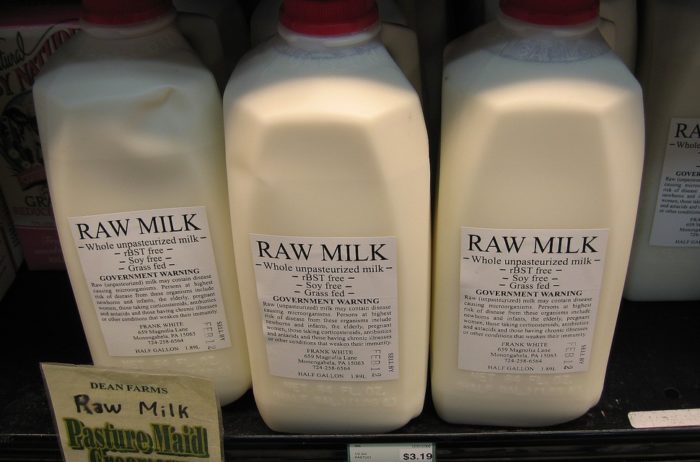Jun 30 2020
Raw Milk is Bad
 It often seems that for every modern advance that helps humanity live safer, more comfortable, and more productive lives there are those who claim that advance is a bane to be avoided, perhaps even the plot of a sinister conspiracy. One of the more perplexing examples is raw milk aficionados. These are people who claim, against all evidence, that raw milk is healthier. A new study adds to the pile of evidence that they are wrong.
It often seems that for every modern advance that helps humanity live safer, more comfortable, and more productive lives there are those who claim that advance is a bane to be avoided, perhaps even the plot of a sinister conspiracy. One of the more perplexing examples is raw milk aficionados. These are people who claim, against all evidence, that raw milk is healthier. A new study adds to the pile of evidence that they are wrong.
Most milk consumed in the US and industrialized nations is pasteurized and homogenized. Pasteurization is the process of flash heating raw milk in order to kill bacteria, making the milk safer and extending its shelf life. The process involves heating milk in stainless steel containers to 161° F for 15 seconds then rapidly cooling down to 39° F. Many European countries prefer ultra-pasteurized milk, which involves heating to 280-300 degrees F for 2-3 seconds. This produces so-called shelf stable milk that does not have to be refrigerated.
Pasteurization undeniably works as advertised. As Mark Crislip summarized over at SBM, the widespread use of pasteurization has reduced milk as a source of human bacterial infection outbreaks from 25% to 1%. Many studies have shown that consuming raw milk is a risk factor for bacterial infection. So why would raw milk proponents claim it is better? They believe that raw milk is more nutritious and tastes better, and contains healthy probiotics.
I am skeptical of the taste claim, but could not find any good blinded studies. I only trust blinded taste tests. Having participated in these myself, it is often shocking how much expectation plays a role in perceived taste. To be generous I will grant this point to anyone who has a personal preference, but I will just caution everyone that you really don’t know until you have done a blind test.
The questions that have more scientific evidence behind them regard safety and benefits. Is raw milk better? The nutrition question has been answered. Here is one study that compares raw milk to standard “Holder” pasteurization and shelf-stable (retort processing or SS) milk:
Macronutrient content is relatively unaffected by processing; Holder pasteurization and retort processing maintain similar fat, lactose, and total protein levels. Lysine and thiamine were significantly decreased by retort processing, but not by Holder pasteurization. Thiamine losses are clinically significant, and fortification may be necessary if SS donor milk is a long-term feeding choice.
For regular pasteurized milk, therefore, there is no significant nutritional difference. Any minor differences are clinically irrelevant. Shelf stable milk has reduced thiamine, which is only an issue if milk is your primary source of thiamine, which is likely not true for most people. Milk doesn’t even crack the top ten in terms of sources of thiamine, which you can get from a variety of meats, vegetables, and legumes.
So the nutrition claim is bogus. What about the claim that raw milk contains beneficial probiotics? That is partially the topic of the current study. They examined raw and pasteurized milk for bacterial content at baseline and over time if left at room temperature vs refrigeration at 4 C. They found – “Despite advertised “probiotic” effects, our results indicate that raw milk microbiota has minimal lactic acid bacteria.”
The claim to health benefits from routine use of probiotics is problematic at best in any case. The best conclusion we can make from existing data is that there is no benefit for healthy people routinely consuming probiotics. There is some open question when it comes to those suffering from irritable bowel syndrome or similar conditions, and also with the use of high culture count probiotics in the early treatment of diarrhea produced by antibiotic use. Even there the data is thin, but a benefit is plausible. But there is clearly no benefit from routine use.
This is a double-whammy for the raw milk claim – routine consumption of probiotics is probably not beneficial, and raw milk doesn’t contain them anyway.
What raw milk does contain in abundance is pathogenic bacteria, those capable of causing infection. Further, raw milk is loaded with antibiotic resistant genes (residing in those bacteria). Consuming raw milk not only risks infection, it is seeding the bacteria already in your body potentially with antibiotic resistant genes. This study does not establish a specific health risk to consuming the resistant genes, but they are a potential hazard.
Unsurprisingly, leaving raw milk at room temperature quickly and dramatically increases the number of bacterial and resistant genes. People do this when they are making a culture for certain products. The authors recommend that a starter culture be used instead. Incidentally, at refrigeration temperatures the bacterial counts were stable (but still higher in raw milk).
The bottom line is that there is no health benefit to drinking raw milk vs pasteurized milk, but there is a clear increased risk from pathogenic bacteria and now possibly from increased spread of antibiotic resistant genes.






